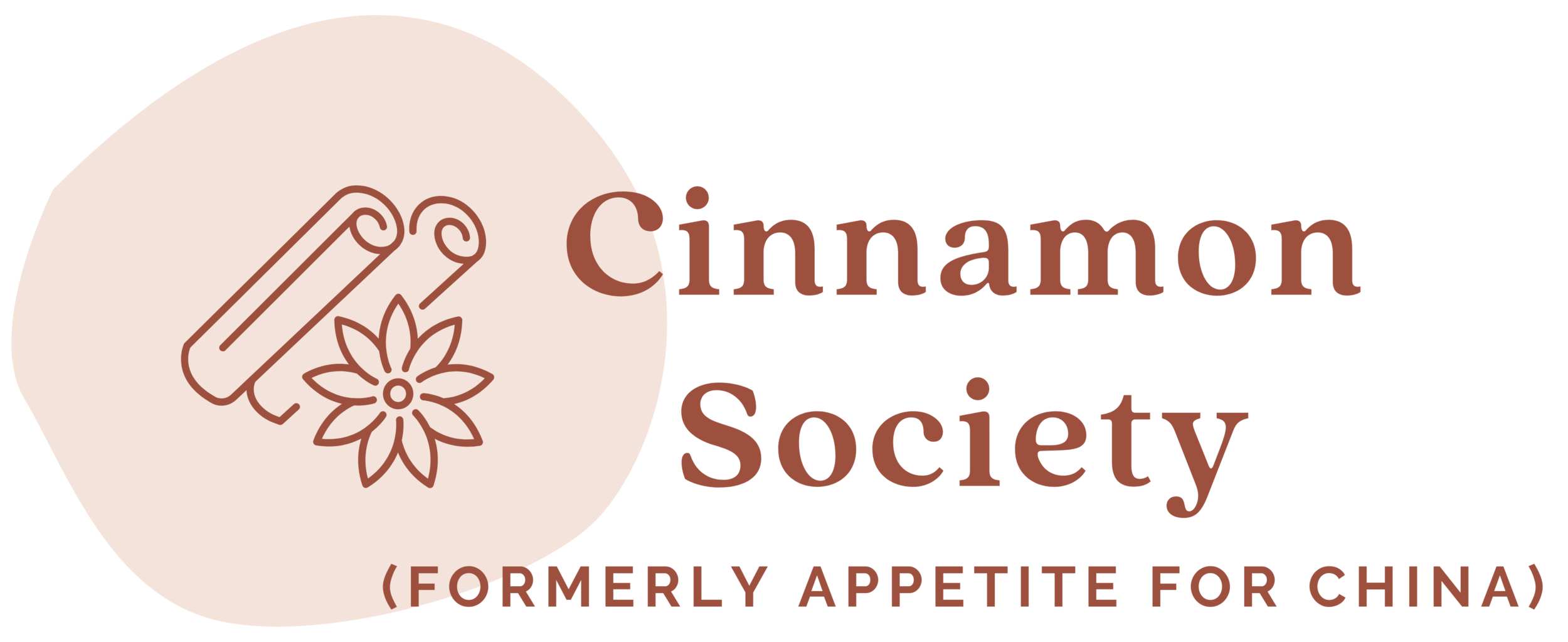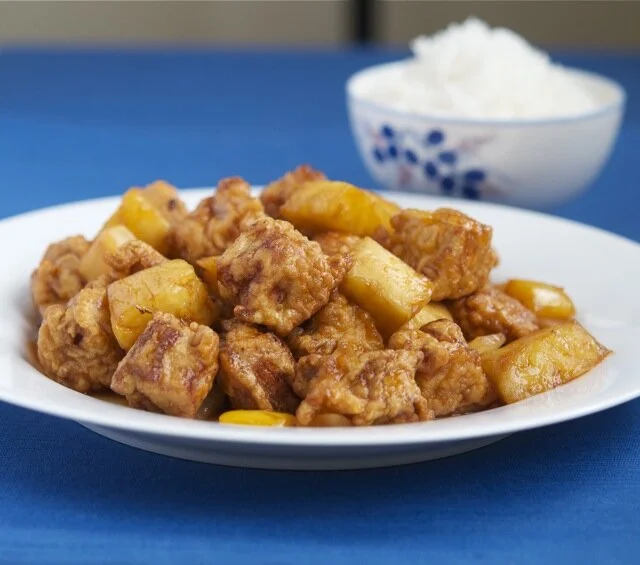What’s the secret to super crispy General Tso’s chicken? I’ll show you in this recipe.
Read MoreSweet and sour pork (or “gu ou yuk”) is thought to have originated in Guangdong province.
Read MoreWhile shopping at the horribly chaotic Target at the Atlantic Center several weeks ago, I noticed something strange in the freezer aisle. Maybe I was just oblivious before, but there was a good number of frozen entrees based on Chinese takeout. Yes, frozen egg rolls and dumplings have been around for a while, and Trader Joe's is no stranger to frozen-foodifying Asian dishes. Now it seems PF Chang's has a shiny new line of "Home Menu" dinners, including Orange Chicken, Beef with Broccoli, and Shrimp Lo Mein, just waiting to be taken home and zapped in the microwave. (These are apparently for all those times late at night when the Golden Panda around the corner is closed, or when 15 minutes of waiting for the delivery guy is too much to handle.)
From an anthropological standpoint, I was dying to buy a package of P.F. Chang's Sweet & Sour Chicken to try in my own microwave. What a great blog post that would make! Then I read the ingredients, became dizzy with complex chemical terms, and turned my cart away from the frozen food section.
That was when I stumbled on a huge display of Archer Farms products, and an entire row of "General Tso's Thick Cut Potato Chips" at eye level. It seems that after exhausting all the possible barbecue and chili flavors on the market, the potato chip industry may have pinpointed Chinese takeout flavors as The Next Big Thing.
Read MoreI've been thinking a lot recently about how the names of Chinese foods vary so much between China and the US.
One example is lemon chicken. In Southern China, lemon chicken usually means a whole bone-in chicken, steamed, chopped up, and served with a light lemon sauce. In the US, you'd get perfect cubes or slices of breast meat that has been fried and coated with a thick lemon sauce. (In other words, more like this.) A few places, like this takeout spot in Park Slope, may serve you something that looks like a lemon chicken kit that you put together: breaded and fried chicken with little seasoning, on top of some iceberg lettuce, and a container of something that's more or less lemon simple syrup.
Another example is Mongolian beef. In Beijing, Mongolian-style lamb or beef is stir-fried with toasted cumin seeds and whole red chilis. In the US, what has become Mongolian beef lacks any whole spices, but is pretty tasty in its own right. The only thing similar to its mainland Chinese cousin is the thinly sliced steak and abundance of leeks. The sauce, when done well, is pretty terrific. The beauty of Mongolian beef sauce is that none of the flavors stand out on their own, but rather, come together (as the Chinese would say) "harmoniously".
Read MoreEvery once in a while I get an craving for greasy Chinese food that's different from what you can find at your everyday takeout stand.
Some of you may remember my Caribbean-Chinese party from two years ago. The theme had been inspired by the wee bit of my childhood that was spent in Puerto Rico and the hybrid dishes I remember eating at Chinese restaurants there, like chicharrones de pollo and pineapple shrimp. I had also added some Jamaican influences as well, including jerk chicken wings and a cocktail made with hibiscus tea. It was a fun event, but needless to say, Caribbean-Chinese food never became a steady part of my diet.
Flash forward to 2010. Today I found myself in Prospects Lefferts Gardens at De Bamboo Express, one of the two or three Jamaican-Chinese restaurants I know of in the city. Objective: a cheap but filling lunch.
Read MoreRecently, while visiting Jacob's grandmother in California, I discovered a torn cookbook in her kitchen drawers. "Oh!" she exclaimed. "You found my bible!"
Titled "Country Cookin'", the book was published in the 1970s by the Monterey County Cowbelles, otherwise known as the wives of Monterey's ranchers. Surprisingly, only a tenth of the book is devoted to red-meat-centric dishes. Most of the recipes are charmingly anachronistic, like Dove in Wine Sauce and Hot Russian Tea (with Tang!). But what really caught my attention were the handful of Chinese recipes.
Read MoreThe frequent travelers among us know that Chinese restaurants are everywhere. Once upon a time you could have visited Dublin or Dubai without seeing an Empress Garden Panda Palace or some variation, but those days are long gone. Like when writer Daisann McLane stumbled upon the Hong Kong Café in icebergian Greenland. A recent commenter on this blog put it best: "It's weird, but I always try to find the 'Chinatown' when I'm international too. I feel comfortable and at home there."
I'm a huge fan of using Flickr for research, and months ago became addicted to this fascinating Flickr pool of Chinese restaurants around the world. Here are 7 favorites:
Read MoreEd. - Say you're at your favorite Chinese take-out, feasting on moo goo gai pan and crab rangoon. "I bet they don't really eat this stuff in China," you think, recalling the Discovery Channel special on TV last month. You would be correct. But how did dishes like chow mein and the once ubiquitous chop suey, unrecognizable to anyone in China, become such so well-loved in the US? Author Andrew Coe explores this and other mysteries of the Chinese-American culinary repertoire in his new book Chop Suey: A Cultural History of Chinese Food in the United States, which came out this week. In today's guest post, he gives a glimpse into the past and present life of chow mein.
Somewhere in America right now, noodles are frying. The chef is preparing chow mein, which simply means “fried noodles" in Chinese. But not all fried noodles are alike. In China, the varieties of chow mein are as numerous as the regional cuisines. Some are lightly heated in the wok, while others, particularly in Guangdong province and Hong Kong, are fried in bunches in oil until they’re browned and crispy on the outer edges but still soft in the middle. It was this southern style of chow mein that was carried to the United States by the Chinese immigrants.
Read MoreLast summer when Jacob went to Budapest for a conference, he took an few hours to stroll around the city's "Chinatown." Except there wasn't much of one, at least not the kind with red-and-gold gates and tons of indistinguishable souvenir vendors - kitschy but telltale signs that a city at least tries to embrace its multicultural identity.
With Hungary, the situation is a little more complicated. Through numerous conversations with Hungarians, many of them ultra-liberal on a range of political issues, there was an underlying resentment of recent Chinese immigrants. The country's Chinese population mostly consists of Fujianese who arrived starting in the 1980s, a good portion who may have entered illegally, and who have not really integrated into Hungarian society yet. It seems like an instance of vicious-cycle tension: newcomers keeping to themselves because of societal disdain, society feeling disdain because newcomers keep to themselves. Despite this, Chinese restaurants were doing okay business, though not nearly the lunch volume as their US counterparts.
Read MoreI came across this Edward Hopper painting today and, for a few minutes, tried to connect the image with the name. The painting is evocative of everything I associate with the 1920s: men in suits, chic flappers, and dim stylish interiors. Yet if you look closely, there is a terracotta teapot on the table. And try to decipher the restaurant placard outside the window. The restaurant and painting are both called "Chop Suey".
Ask Americans what comes to mind when they think of Chinese restaurants. The adjectives you'll most likely get are along the lines of cheap, quick, and dingy with fluorescent lighting. Chinese restaurants are now the culinary equivalent of love motels.
I'm not talking about banquet halls in Chinatowns that cater to the Chinese, which also tend to be lackluster. I'm talking about restaurants for the other 99.5% of America. Whether they know it or not, these greasy take-outs, Panda Expresses, and P.F. Changs serve as cultural ambassadors for Chinese food and culture. And what they represent is cheap food for the masses, not culinary sophistication.
Read MoreSoutheast Asia is a food lover's playground, and no food blog captures the region better than Eating Asia. Robyn Eckhardt and her husband Dave Hagerman have spent the past 4 years hopping around Malaysia, Vietnam, Thailand, and other spots, blogging and freelancing for publications such as The South China Morning Post and Time Out Kuala Kumpur. From banh mi snackdowns to portraits of Penang's cooks and street vendors, Eating Asia's posts reveal a intense passion for both the food and the people behind the food. And the photos will leave anyone starving for more.
How did you become interested in blogging about the cuisines of Asia?
First came an interest in writing about the cuisines of Asia and, following logically from that, a desire to write well about the cuisines of Asia. I wanted to become a better writer but I needed a prod to practice. The blog gave me a reason to sit down in front of the computer on a regular basis and write (the photographer had a similar impetus to blog). What was your perception of Chinese food before you first visited China?
Oh goodness, I grew up in suburban Detroit in the 60s/70s, so you can probably imagine what my perception of Chinese food was! My family often picked up Chinese carryout on Sundays -- egg foo yung (I still don't know exactly what it was), chicken chop suey, fried rice, chicken peanuts, bland and mushy mixed vegetables. In uni (still in Michigan) my roommate introduced me to crab rangoon and my now-husband introduced me to guotie with chili oil, but that's as far as it went.
Read More

